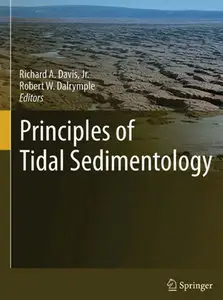"Principles of Tidal Sedimentology" ed. by Richard A. Davis, Jr., Robert W. Dalrymple
Sрringеr SсiBus | 2012 | ISBN: 9400701225 9789400701229 9789400701236 | 638 pages | PDF | 50 MB
Sрringеr SсiBus | 2012 | ISBN: 9400701225 9789400701229 9789400701236 | 638 pages | PDF | 50 MB
This book presents a comprehensive, contemporary review of tidal environments and deposits, overview of tidal sedimentology. The approach is comprehensive with state-of-the-art reviews of the full spectrum of tidal depositional environments, from supratidal salt marshes, through the full range of coastal environments and continental shelves, to the deep sea.
Examples from modern environments and ancient deposits are provided, and both siliciclastic and carbonate environments are discussed.
The book is organized in the following four parts.
1) Chapters 1 – 4 provide overviews of the fundamentals of: the generation of tides, the nature of sediment transport by tidal currents, the criteria by which tidal deposits can be recognized, and the ichnology of tidal deposits.
2) Chapters 5 – 14 review the charac teristics of the full range of siliciclastic tidal environments, including both tide-dominated estuaries and deltas, as well as the various tidal components of barrier-lagoon systems. These chapters cover all aspects of the sedimentology of these environments, from the details of the physical processes operating in them, through the morphodynamics and facies, and the stratigraphic organization of the deposits.
3) Chapters 15 – 18 provide syntheses of particular times and places in earth history where tidal deposits are particularly notable.
4) Chapters 19 – 21 discuss tidal sedimentation in modern and ancient carbonate environments.
Brief Contents
Preface
Contributors
1: Tidal Constituents of Modern and Ancient Tidal Rhythmites: Criteria for Recognition and Analyses
2: Principles of Sediment Transport Applicable in Tidal Environments
3: Tidal Signatures and Their Preservation Potential in Stratigraphic Sequences
4: Tidal Ichnology of Shallow-Water Clastic Settings
5: Processes, Morphodynamics, and Fades of Tide-Dominated Estuaries
6: Stratigraphy of Tide-Dominated Estuaries
7: Tide-Dominated Deltas
8: Salt Marsh Sedimentation
9: Open-Coast Tidal Flats
10: Siliciclastic Back-Barrier Tidal Flats
11: Tidal Channels on Tidal Flats and Marshes
12: Morphodynamics and Fades Architecture of Tidal Inlets and Tidal Deltas
13: Shallow-Marine Tidal Deposits
14: Deep-Water Tidal Sedimentology
15: Precambrian Tidal Fades
16: Hypertidal Fades from the Pennsylvanian Period: Eastern and Western Interior Coal Basins, USA
17: Tidal Deposits of the Campanian Western Interior Seaway, Wyoming, Utah and Colorado, USA
18: Contrasting Styles of Siliciclastic Tidal Deposits in a Developing Thrust-Sheet-Top Basin - The Lower Eocene of the Central Pyrenees (Spain)
19: Holocene Carbonate Tidal Flats
20: Tidal Sands of the Bahamian Archipelago
21: Ancient Carbonate Tidalites
with TOC BookMarkLinks



